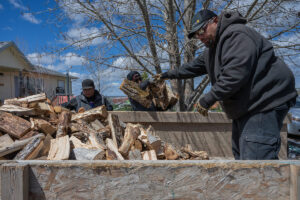by Lindsey Winkel, Intermountain Region

(July 26, 2024) — Bordering southern Idaho, in Owyhee, Nevada, winter temperatures can dip below zero degrees on the Duck Valley Indian Reservation. For Shoshone-Paiute Tribal members, burning wood to heat their homes has been a way of life for generations.
“We’re remote. We’re on the last mile of the power grid so it’s very important that we have alternate sources of heat, and there are a lot of homes in the valley that do not have electricity, so their only source of heat is wood,” explained Tribal Chairman Brian Mason. “As we’ve harvested wood as a community, you find that you have to go further and further into the hills to find wood. It’s a limited resource, especially in Nevada.”
In the last three years, the Wood For Life program has delivered more than 1,500 cords of wood from the Sawtooth, Boise, and Payette National Forests to the Duck Valley Reservation. Through an agreement with the United States Department of Agriculture’s Forest Service and a partnership with the National Forest Foundation, wood removed during forest health restoration projects on National Forest land is being utilized as fuelwood for Tribal community members who need it most.
“We specifically targeted elders because they are the least advantaged and the most vulnerable people that we have in the valley,” Mason said. “It’s our job as Tribal government to make sure that we’re taking care of the most vulnerable. So, we applied the Wood For Life program and made sure that each elder got at least two cords of wood, and it has worked out well.”
The Boise and Payette National Forests have 230,000 acres of hazardous fuels that are being treated through the Forest Service’s strategy to confront the wildfire crisis. Typically, the wood removed from these projects is lopped and scattered, chipped, or piled and burned. The Wood For Life program offers a more sustainable use for wood that would otherwise be disposed of and delivers it to a Tribal wood bank instead. The program also creates jobs for Tribal members that process the wood into firewood.
“They had very little resources in the beginning. They were using their own vehicles and trailers. They worked outside in the snow and the rain, no building, no office. Our wood manager created his reports from his truck,” said Tribal Councilwoman Addie Parker.
Last winter the crew built a small pole shed to have some cover from the elements. This year they purchased an enclosed shed to store their chainsaws in. Parker explained that the plan is to eventually get a bigger shop space, but even without one, the crew didn’t let the weather stop them from delivering over 500 cords of wood to tribal members last winter.
At the wood bank’s yard, the processed wood is stacked and divided by the cord, a standard firewood measurement of 8 feet long, 4 feet high, and 4 feet wide. The wood bank is currently receiving more log deliveries from the Boise National Forest, and this year they expect to process and distribute 500-600 more cords.
“When we see people out in the community, they’re always telling us thanks or shaking our hand for the stuff we do for them or hauling wood to them,” said Bud Hanchor, a sawyer on the crew. “The Wood For Life program has helped out this community a lot.”
The crew have been training to advance their skills as sawyers and wildland firefighters, expecting to assist the Boise and Payette National Forests on the ground; with increased training the tribal sawyers will have the opportunity to work on their ancestral homelands and assist with projects as co-stewards. A long-term goal is to one day be independent enough to provide fuelwood from their co-stewardship projects to the Tribes’ wood bank.
“We’ve taken a lot of the burden off of the tribal members, especially the elders,” said Mason. “To have a group of young men and women show up to stack your wood, sometimes you don’t want them to leave, just for the conversation. They’re filling a void. It’s not just wood. They’re showing future generations what hard work looks like. They’re setting examples.”
The Wood For Life program launched in 2019 in northern Arizona, then expanded to New Mexico and Colorado. After more success in Idaho, the program is expanding to serve Tribes in Utah. You can read the Forest Service’s Tribal Action Plan to learn more about its commitment to strengthening Tribal relations, and providing better access to agency programs, services, and co-stewardship opportunities, or watch a video of the program’s partners in action.
